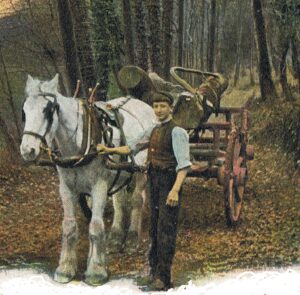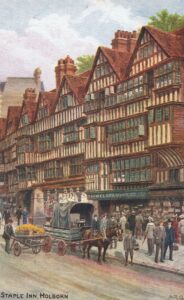This was the third visit (1st on Zoom) by Prof. Ian Rotherham of Sheffield Hallam University, who is an author, broadcaster and campaigner on environmental issues.
With the prospect of the planting of the Great Northern Forest, between Liverpool and Hull, extending down into South Yorkshire, todays talk was very topical.
To begin with, some definitions:-
Forest – a landscape with a high density of trees.
Woodland or woods – a low density forest, which arose naturally, but then was managed, and may include clearings, shrubs, shade, and grassy areas.
Ancient Woodland – Woodland that has existed at least since the 1600s.
Timber – The large size pieces used in e.g. construction, mainly oak, as in cruck houses or box framed dwellings.
Wood – The smaller pieces e.g. small diameter poles cut from coppice and used for fuel and wattles etc.
Coppice – Trees cut down to ground level so that they regenerate and ‘’spring’’ into regrowth. Hence in Sheffield, ‘’Ladies Spring Wood ‘’, ‘’New Field Spring Wood’’ and ‘’Parkwood Springs’’ where the coppicing was used to make charcoal into the 1880s.
Pollard – Trees cut down for shaping or regeneration, at a point above where an animal can get at it.
Shredding – harvesting of firewood and animal fodder,while preserving a tall main trunk which may be harvested for timber at a later date.
Herbage – leaves from when pollarding or coppicing takes place. Preferred by cows, rather than grass.
Standards – Trees grown in the open with no management.
Wavers – young standards
In 1992, there was a National Woodlands Conference instigated by the Peak National Park, between Ecologists, Foresters and Archaeologists to discuss the history, and to co-ordinate future protection, of our ancient woodlands. The proceedings were recorded as ‘’Ancient Woodlands – Their Archaeology and Ecology’’. Inspiration was drawn from publications by Prof. Oliver Rackham, our own Prof. Mel Jones. Also, from a 1600s publication by John Evelyn entitled ‘’SYLVA’’, which told how wood was processed, and a Welshman Thomas Pennant, in 1772, who wrote about how trees and local resources are used throughout the country.
If we were to go back to medieval times we would find a very different landscape. Peoples lives were dominated by the natural materials around them, and woodlands were vital resources and busy places, where animals foraged, people lived, and there were even paved tracks for packhorses. The peoples names reflected the trades and crafts that fed their lifestyle – Carter, Cartwright, Wood, Underwood, Croft, Fletcher, Warren etc.
There were charcoal makers, besom makers, bow and arrow makers, wheelwrights etc, and all the buildings were built using locally sourced materials.
Styles of construction around the country depended on the type of timber available. Uplands had birch but in the fens with no timber they used mud, withies, turf, and reeds. Nothing went to waste. Clay, bracken, fungi, wattle and daub, and stone were used. (Wharncliffe was the biggest supplier of Quern stones for grinding in the Roman Empire). Bark was used for tanning, which was best in spring when the sap was rising, and timber was felled in winter after leaf fall, chosen by a master craftsman. Structural timbers were felled when the tree was 50 – 150 years old. This was then box halved with cross saws in a saw pit, (hence top dog and under dog). Some large trees are thousands of years old and have been pollarded and harvested about every 15-20 years, but have to be retired eventually, due to old age. They can be cored to find out when they were last pollarded. They then develop their own ecosystems and become status symbols. In Japan bamboo is used, and in North America log cabins abound, as timber was plentiful, and the purchase was financed by potash sales.
Examples of local old pollarded trees are
– The Old Man of Longshaw which is an oak, with bent branches and roots, with the spreading having been encouraged deliberately, to allow acorns to fall over a bigger area for pigs to forage.
– In Yarncliffe Wood in Padley Gorge, where cutting was last done in 1822, some trees are distorted and are lying over themselves.
Ecclesall Woods, an ancient woodland, has evidence of Neolithic activity, through to the late Saxons, and a subsequent history of being a mediaeval and deer parkwhere coppicing took place. Once, lots of cows and pigs foraged there too.
The ancient woodland of Holmesfield Park Wood has holly, indicating its origins as a deer park.
Under the flexible Saxon law, people were allowed to go anywhere and there was only tribal ownership. In the Domesday book of 1086, the Normans introduced the Feudal System and Dukedoms across England. The Dukes were allocated woodland and trees, and areas such as woodland pasture, open land, and large landscapes, with everything controlled by the monarch. Castles e.g. Conisborough were erected to enforce this.The peasants were now confined to small areas of common land. Some areas became deer parks and were used for sport or hunting, so wooded and forested landscapes were contested because of different demands. The Act of Commons in 1235 consolidated this administrative structure, fixing parishes, manor estates, and who had what rights. Hedges date from this time. This system endured until the 1800s, when the unenclosed commons were enclosed. There was conflict between the landowners and commoners, who turned to poaching and rioting. The owners of the land allowed the peasants access for 2 days a year to gather wood, either off the ground or from the tree that could be reached with a shepherds crook. Hence the term ‘’By hook or by crook’’.
From the 1600 and 1700s the iron barons of Sheffield managed their woodlands on an Industrial cycle, with intensive coppice management for smelting and mining, until different methods were discovered. Pollarding/coppicing took place depending on the type of tree, from 15 year cycles to 70 year cycles. The peasants did have some rights to harvest bark for tanning, and wood for buildings, clogs, potash and charcoal, and animals were allowed to forage for acorns and leaves. People seeking nuts, called ‘’nutters’’ were ‘discouraged’, as reported locally in 1809. More people came to the cities, as the lands had been enclosed, and alternative work was available in the new industries. Less resources and more rules gave problems to the commoners who rioted as they were starving and dying of cold. The Lord was all powerful as he made the rules, managed the woods and was the judge in any disputes. There was no justice and the people became slaves to the Industrial Revolution. There was a cultural severance from country life. Forestry in the 20th century eventually was introduced to replenish the dwindling stock of timber to cater for modernisation and urbanisation.
Despite all the above, Sheffield has 80 ancient woodlands and 180 woods which cover 10% of the city area and make us the most wooded and treed city in Britain. The following publications give further information.
‘’The Historic and Heritage Trees of Sherwood Forest in myth and legend, in life and death’’, by Ian Rotherham
‘’ The Woodland Heritage Manual’’ by Ian Rotherham
‘’Sheffield Woodland Heritage’’ by Mel Jones.
The morning was a most enlightening and interesting insight into our Woodland Heritage.



